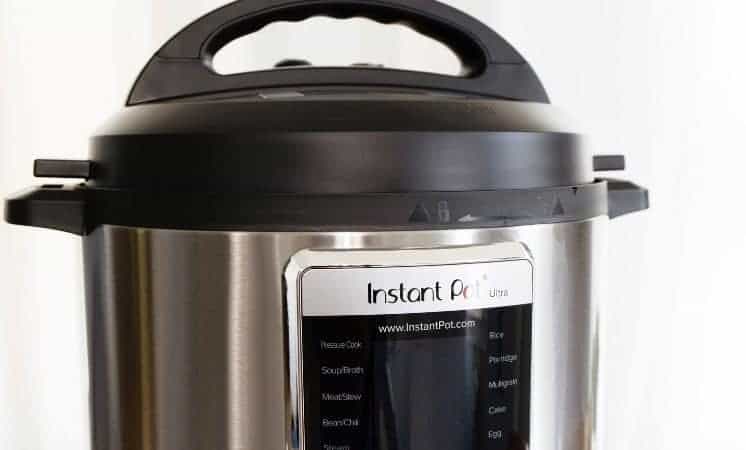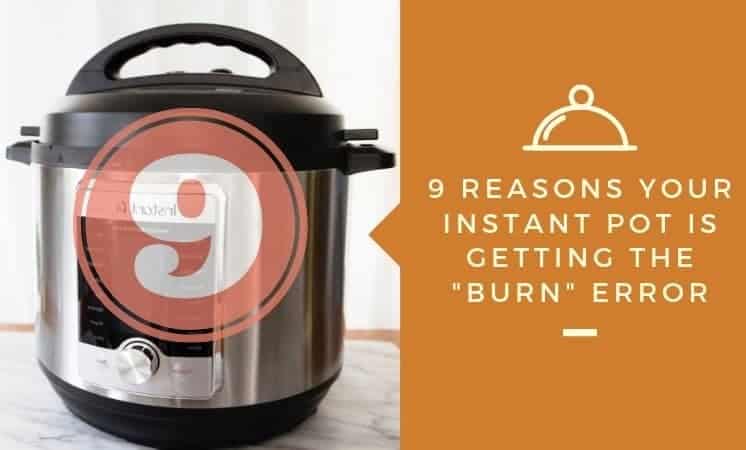Instant Pots are known for their ability to automate the cooking process, in fact, the cook doesn’t have to be present once the ingredients have been added and the lid has been sealed.
The Instant Pot can also detect potentially harmful conditions and shut off to prevent the user from operating the Instant Pot under such conditions. Overall, the Instant Pot is a very smart appliance capable of regulating pressure and temperature, prevent harm, and send error codes.
After solving the burn error multiples times on Instant Pots that belong to me, and then a couple of more times on Instant Pots that belong to my friends, I’ve gathered some serious experience in the area.
Why does my Instant Pot say burn? The burn message on an Instant Pot tells us that the Instant Pot’s burn-protection has detected high temperatures (140°C or 284°F) at the bottom of the stainless steel insert and as a result, automatically shut off to prevent food at the bottom of the Instant Pot from scorching.
On older models, the burn message may be displayed as an “Ovht” error code on the Instant Pot’s display. Some say that newer models with the burn message tend to display it more frequently – perhaps newer models are capable of reaching higher temperatures when cooking which triggers the protection sensors.
It’s important to keep in mind that these error codes aren’t an indication of your Instant Pot’s well-being. In fact, they just tell us that we’ve approached a recipe the wrong way. Displaying these messages is part of how an Instant Pot works, which is a great feature for both beginners and veterans.
Cooking in a pressure cooker requires very little maintenance. The lid and the container are sealed shut once pressure has built up and can’t be opened until the pressure cooker has depressurized. This prevents the user from stirring the food throughout the cooking process – which can cause food at the bottom to burn quite easily if not cooked the right way.
Now that we understand why Instant Pots, in theory, get the burn message, let’s take a look at what may be causing your Instant Pot to display the error code and how to prevent it from happening.
Why Your Instant Pot is Getting the Burn Error and How To Fix It Easily

Networking with other people, both on- and offline, has given me the answers to a bunch of different questions regarding these machines. Down below I have gathered the things that may cause your Instant Pot to display the “burn” error code – and how to solve them.
#1 Not Enough Liquid
Instant Pots and Pressure Cookers both work by building up steam pressure. When the liquid inside the sealed cooker starts boiling, steam is produced. The cooker doesn’t provide an escape route for the steam which causes the pressure inside the cooker to increase. This cannot be done without liquid.
Without liquid, the food at the bottom of the Instant Pot will scorch and stick to the inner pot.
SOLUTION: If this happens to be the reason why you’re getting the burn message, well, then you’re just two cups of water away from solving it.
The easiest way to solve this issue is to make sure to add at least the minimum amount of water required every single time – which is 1 cup in the case of the Instant Pot, according to the companies Facebook Page. Of course, the amount of water required depends on what you’re cooking – some foods absorb more water than others and, therefore, they require more liquid.
Wine, broth, beer and other liquids of the same viscosity counts toward the liquid limit. Sauces or liquids that are thicker than the options above are too dense and don’t count towards the minimum amount of liquid. Foods such as vegetables release liquids when cooked, this liquid also counts.
Prior to starting the cooking cycle, make sure that the liquid has been able to get to the bottom of the Instant Pot.
#2 Liquid Added is Too Thick
You’ve added liquid in the form of tomato sauce from canned tomatoes and mixed it with the rest of the ingredients – now, the cooking liquid is too thick to come to a boil. The bottom of the Instant Pot will build up heat before it reaches the top and trigger the burn message.
SOLUTION: Always have thin liquids at the bottom of the cooker. If adding thicker liquids such as tomato sauce, make sure that you add it as a layer on top of the other ingredients. It’s important that the amount of thin liquid exceeds the amount of thick liquid.
#3 Your Recipe Was Made For a Different Instant Pot Size
Different sized Instant Pots may require more liquid to come to pressure. Using a recipe suitable for a 6 quart Instant Pot in an 8 quart Instant Pot may be the reason why you’re getting the burn message.
SOLUTION: You can choose to just add more liquid to the cooker or double the recipe. The cooking time should stay the same.
#4 You’re Pressure Cooking Dairy Products
While it may seem tempting to add milk or cream to the Instant Pot, one must keep in mind that these foods scorch with minimal effort. When cooked, these ingredients will create a thin film at the bottom of the cooker which will cause the Instant Pot to overheat – triggering the burn message.
SOLUTION: If you wish to add milk or cream to a recipe, I suggest that you do so after pressure cooking the meal.
#5 The Sealing Ring Doesn’t Work Properly
The Instant Pot’s container and lid are sealed shut with the help of a sealing ring. If your Instant Pot’s sealing ring is missing, damaged or installed badly, the steam inside the pot will escape. Without moist, the food at the bottom of the cooker will scorch. This causes your Instant Pot to display the burn code.
SOLUTION: Sealing rings don’t last a lifetime, and many pressure cooker companies suggest that they should be replaced annually. However, before you consider purchasing a new ring, make sure that your ring is pushed into the track all the way around the cooker and that it’s cleaned properly after each use.
#6 Steam Release Switch is “Venting”
Prior to starting the Instant Pot, you may have forgotten to turn the venting knob from “Venting” to “Sealing”.
When sealed, the Instant Pot releases excess pressure in the form of the steam. However, in the venting position, the Instant Pot will allow most of the liquid inside the cooker to escape. This is just as bad as cooking with less liquid than neccessary.
SOLUTION: Put a note on the Instant Pot to remind yourself to always switch from “Venting to “Sealing” prior to cooking.
#7 There’s Food in The Sealing Ring Rack
The sealing ring is supposed to fit perfectly in a rack between the cooker and the lid. Cleaning both the ring and the rack is an easy way to prevent food from clogging the path. If the ring can’t seal properly, steam will escape the cooker.
SOLUTION: Clean the ring after each use and make sure that there’s nothing stuck in the sealing ring’s rack.
#8 You’re Cooking Ingredients That Are High In Starch
Ingredients such as pasta and rice may cause the burn error to display if they are mixed in with the rest of the ingredients.
SOLUTION: Similar to tomato sauce and other thicker sauces, pasta and rice should not be stirred and mixed with the rest of the ingredients. Instead, add them last, on top of the other ingredients. Just make sure that they are covered by the liquids – if they aren’t, gently press them down with a spoon or other object until they are covered in liquid.
#9 The Saute Function Was Used Prior To Pressure Cooking
The Saute function can cause food to get stuck at the bottom of the Instant Pot. Going from the Saute function to Pressure Cooking without letting the appliance cool down and deglazing it can surely trigger the burn message.
SOLUTION: When finished sauteing, the Instant Pot should be deglazed. Deglazing an Instant Pot is an easy procedure:
- Add water, wine or broth to the Instant Pot while it’s still hot.
- Using an object that doesn’t harm the Instant Pot, scrape off the food stuck on the bottom.
Deglazing an Instant Pot ensures that there’s nothing blocking the ingredients from getting in contact with the surface of the cooker and the Instant Pot’s sensors from sensing and regulating.
I use silicone or wood utensils when scraping food off my Instant Pot and that’s what I recommend using to ensure that no harm is done to the surface.
What Should I Do When I Get the Burn Notice on My Instant Pot?

Collect yourself! There’s nothing wrong with your Instant Pot. Now that you know what causes an Instant Pot to display the burn message and how to avoid it, you will surely get it less frequently. With that said, if you were to get it again – this is how you should handle it.
- 1# Start by releasing the pressure (if your pressure cooker is under pressure). Do so carefully and make sure that no part of your body is close to the release hole as pressure will escape in the form of super hot steam. Never try to open the lid without releasing pressure first.
- 2# When the Instant Pot has depressurized, open the lid to check if there’s food stuck to the bottom. Open the lid carefully, especially if you’ve got thick sauces in there as they may splash.
- 3# If there’s burnt food at the base of the cooker, you need to remove it. There are two ways to do so, which technique is most effective depends on the degree of the burn. Small stains can often be removed by scraping the bottom of the cooker with a wooden spoon or spatula but badly burned food and blackened stains may require that you remove the content of the cooker and soak the inner pot in a mixture of warm water and soap.
- 4# If there’s no burnt food at the base of the cooker but there’s no liquid left, add more liquid, stir thoroughly, and resume the cooking cycle.
If you opened the cooker only to find that no food has burned to the bottom and that there’s still sufficient liquid in the cooker, proceed to:
- 5# Make sure that nothing has stuck between the inner pot and the heating element. Proceed to check if the sealing ring, float valve, and venting knob are in good condition and mounted properly.
- 6# Resume the cooking process.
Pro Tip: I recommend purchasing an extra inner pot for your Instant Pot, I did so right away and it has come in quite handy in times like these. The listing on Amazon has three size alternatives and they’re all affordable.
Can an Instant Pot Explode?

Millions of Instant Pots have been sold and no real harm to a user has been documented. This is because of how advanced Instant Pots are. They can regulate temperature and pressure, activate the heating element gradually, and shut off when unsafe conditions are detected.
Even though Instant Pots come with various safety features that lower the risk of an explosion substantially compared to traditional stovetop pressure cookers, it’s still possible for an Instant Pot to explode.
Remember that we’re dealing with boiling liquids and pressure trapped in a small container. Throughout the process, the Instant Pot releases excess pressure through a release hole. Imagine what would happen if that hole was clogged up.
Like all pressure cookers, the Instant Pot should be handled with care. Using an Instant Pot is nothing like handling a slow cooker; you should definitely not set it and forget it.
Your Instant Pot could explode:
- If you got a defect unit
- If the lid is opened while the Instant Pot is pressurized
- If the Instant Pot’s safety features fail to react
- If the release vent is clogged
Down below are some easy guidelines that lower the risk of an explosion.
- Use enough water – 1 cup minimum
- Don’t overfill the Instant Pot
- Keep in mind that some foods expand when cooked – rice, lentils, and beans, for example.
- Don’t leave your Instant Pot unattended. If the Instant Pot runs out of liquid it will overheat.
Oftentimes, things that apply to Instant Pots also apply to other electric pressure cookers. While they aren’t always built the same way, they still operate on the same principle.
Thank you for reading and good luck cooking.

